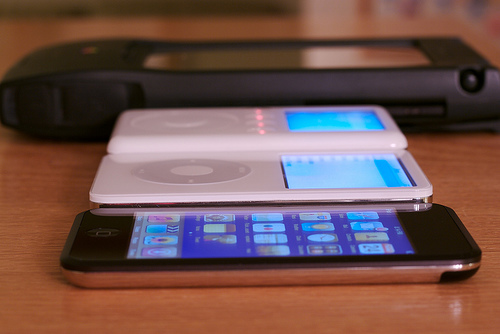First, I need to clarify something. I'm not going to call this "mobile learning" or even the more web2.0 friendly "mLearning." (although I've tagged this post with both monikers, because that's what everyone else seems to call it). What I'm describing is simply the application of small, portable, personal devices with various features that can be leveraged in interesting ways to support and enhance the activities of teaching and learning. By calling it "mLearning" there is an inordinate emphasis on the shiny technology, and less so on their appropriate pedagogical applications.
Second, the concept of using mobile devices to support teaching and learning is nothing new. The New Media Consortium's 2008 Horizon Report outlines some of the educational ramifications of mobile broadband. There are several pages on del.icio.us tagged with "mlearning" pointing to much more discussion on the topic.
What is interesting is the rapid pace of development of various network-enabled mobile devices such as the iPod Touch, iPhone, Blackberry, and other sophisticated and convergent smartphones. We are now carrying devices in our pockets which are running modern operating systems, on processors more powerful than were found in high end workstations only a few short years ago. These devices now let anyone access advanced applications, with broadband Internet access and, cameras, and geolocation. We now have devices available that rival or surpass the mythical tricorder in power, mobility and flexibility.
Again, this isn't new - I was writing term papers, printing, faxing, and accessing the network in the mid 1990s from a handheld Newton Messagepad 120.
[caption id="" align="aligncenter" width="500" caption="Newton MessagePad 120, and three generations of iPods - including an iPod Touch, which finally matched much of the functionality of the MessagePad (but over a decade later)."] [/caption]
[/caption]
What has changed is the cost - my MP120 cost nearly a grand, over a decade ago (IIRC, the MP120 cost about $850 back then. after adjusting for inflation that is now equivalent to over $1200). Devices now cost only a couple hundred bucks. These things are now accessible by nearly anyone that wants one.
Which begs the question - what can we do with all of this mobile power suddenly available? How does this change the nature of educational technology? What new activities are now possible, and how can they be applied pedagogically? This is about more than having a bunch of shiny pocket sized devices available. This is about what pervasive, ubiquitous, mobile devices can do to enhance and extend the activities of teaching and learning.
The simplest application is just by allowing access to the Internet - web, email, instant messaging, from anywhere. Students can call up references from the classroom or lab, or even while experiencing activities in the field. This has been possible for awhile, but smaller devices make it easier and more likely to be used (and used effectively).
[caption id="attachment_1990" align="alignright" width="100" caption="Geolocation, putting a person on a live map."] [/caption]
[/caption]
Geolocation can be used to place a person on a map, find information about that location, and to find other people who are nearby (or are interested in that region).
Where it gets really interesting is in the intersection of location awareness and augmented reality. Mobile applications they know where a person is, what they're looking at, where they've been.
A student at an ecological field station can call up photographs taken at a given location over the last several years. Someone on a marine research vessel can call up images, audio and video describing the organisms that arebeing retrieved by the trawling nets on the ship. They can post media to document and share the experience. GPS coordinates can be embedded, making the media relevant to other classes and researchers.
[caption id="" align="aligncenter" width="500" caption="Augmented reality - enhancing an experience by drawing on location awareness and networked data to enhance an experience in real time."] [/caption]
[/caption]
It's not much of a stretch to imagine an application that is able to leverage the location-awareness of the mobile device, accessing information over the network to add layers of additional information based on what a person is doing, where they are looking, and what they need to learn about.
The hype has been heard before. Technology will change everything! All we need is a little more technology! Look! Shiny things!
[caption id="" align="aligncenter" width="500" caption="The production of an early form of mobile device with interesting applications in the practices of teaching and learning."] [/caption]
[/caption]
But, I really believe that there are many extremely interesting, and pedagogically sound, applications of these new devices. We just need to be careful about buying into the hype without thinking about how we should use this stuff. I'm not going to try to catalog a long laundry list of possible applications of mobile devices - I'm quite sure that the most interesting uses can't even be imagined yet. But we need to start thinking hard about how we will integrate these applications, and how we will adapt our teaching and learning where relevant.
ps. the first draft of this (exceedingly long) blog entry was written on my iPod Touch, using the Notes application. I then emailed this so I could finish the post on my laptop (adding the images and links).